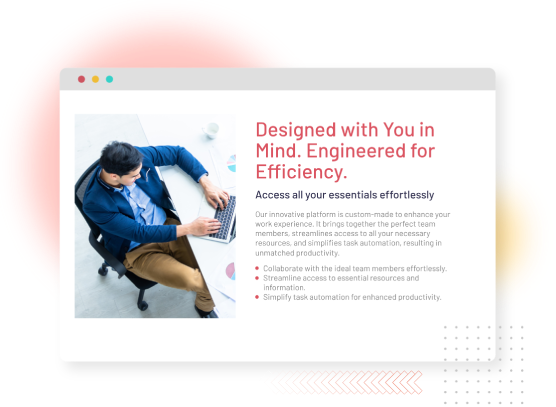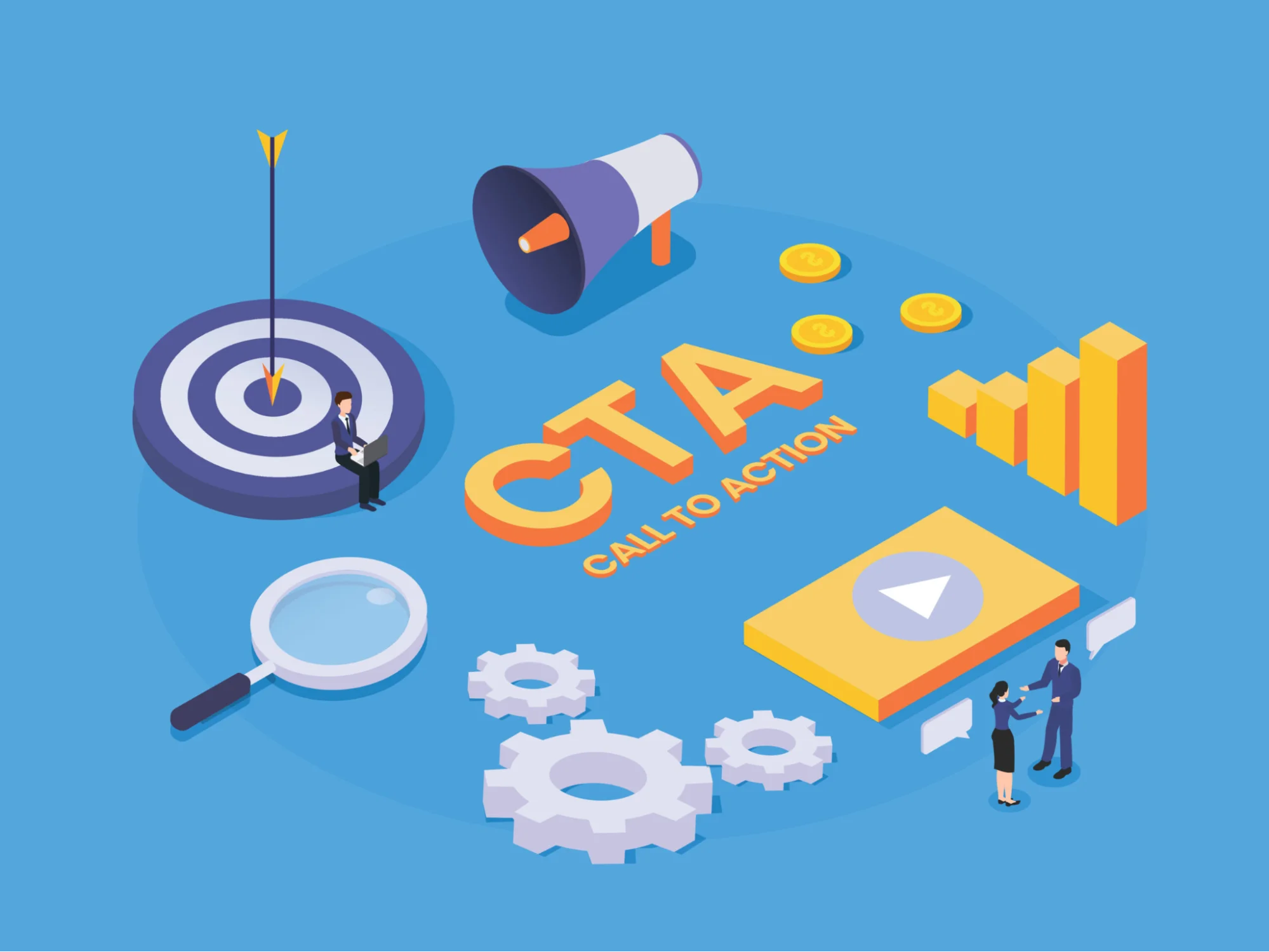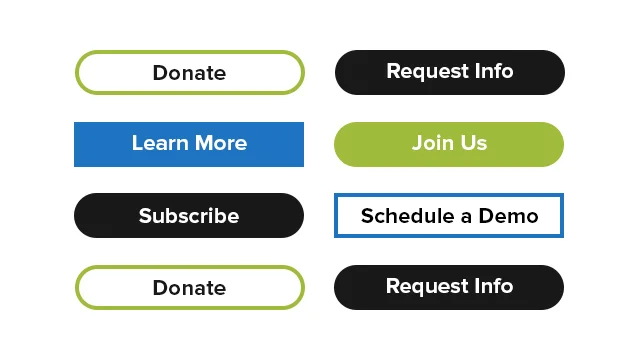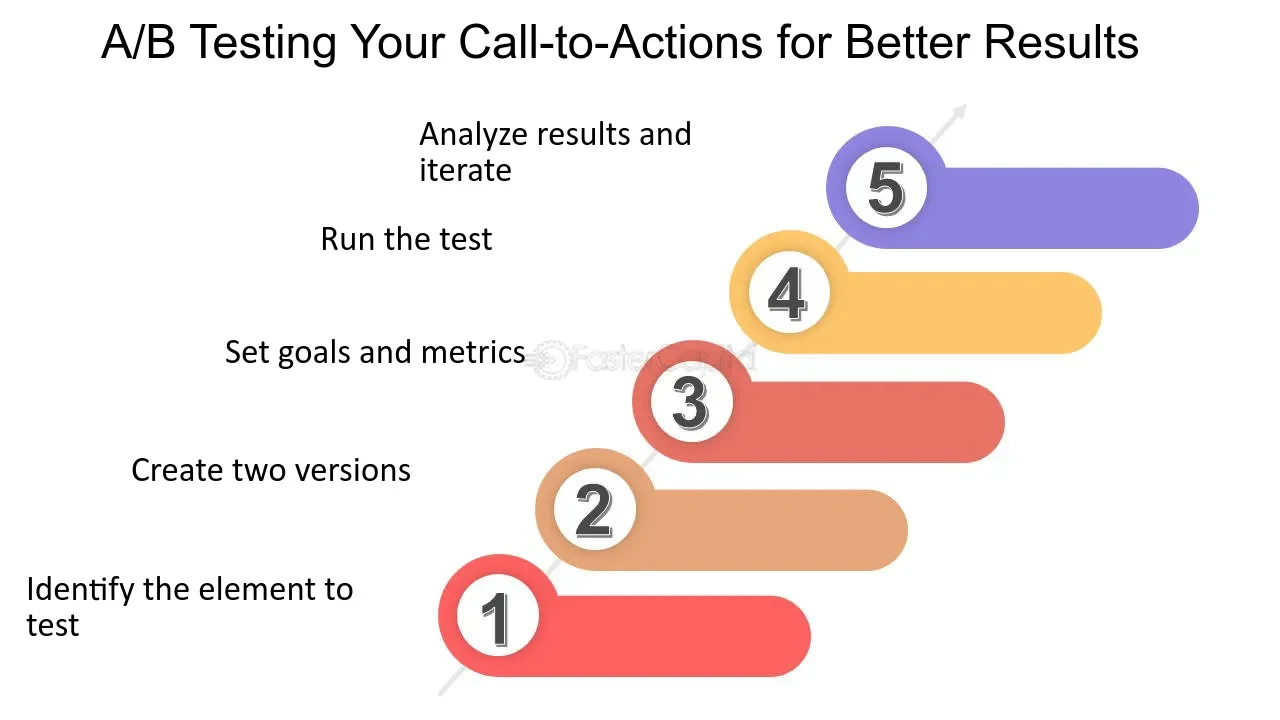

Think of a website as a digital salesperson. It should inform visitors and guide them to take action. Potential clients might need clear directions to contact Lisa, even if they're interested in her services.
A call-to-action, or CTA, is like a friendly prompt on your website. It tells visitors what to do next. For Lisa, a good CTA might say "Book a Free Consultation" with a button to schedule a call. This shows visitors exactly how to take the next step in working with her.
Every business website needs strong CTAs, written with the help of website content writing services. They help turn casual browsers into potential clients. Whether you want people to request a quote or download whitepapers, a well-crafted CTA makes it happen. It's the secret to making your optimized website content an effective business tool.
A call-to-action (CTA) is not a link or a button on your website. It's a strategic element designed to prompt immediate response from your visitors. Whether you want them to purchase, sign up for a newsletter, or download a free resource, a well-crafted CTA guides users to take that crucial next step in their journey with your brand.
Imagine when a salesperson greets you but never offers assistance or directs you to the checkout. That's what a website without effective CTAs is like. CTAs provide clear direction, reduce decision fatigue, and boost conversion rates. They're the friendly digital salesperson guiding visitors through your virtual store.
|
Did You Know? Due to their more recognizable and engaging design, button-shaped CTAs have a 45% higher click-through rate than simple hyperlinked CTAs. |
Crafting a powerful CTA involves several vital elements.
These elements work together to create a CTA that catches users' attention and persuades them to take the desired action.
When writing your CTA, use strong verbs that inspire action. Instead of vague phrases like "Click here" or "Submit," opt for specific, energetic language. "Discover your perfect style," "Start your free trial," or "Get expert advice now" are examples of CTAs that stress upon value proposition and result in immediate engagement.
Your CTA should be a beacon on your webpage, drawing the eye naturally. Use contrasting colors that align with your brand palette but stand out from the background. Make the button or text large enough to be easily readable. Use subtle animations or hover effects to make the CTA more interactive and engaging.
Where you place your CTA can significantly impact its effectiveness. While above-the-fold placement is often recommended, feel free to experiment. Consider placing CTAs at natural decision points throughout your content. For longer pages, you might include multiple CTAs to catch users at different stages of interest.

One size doesn't fit all when it comes to CTAs. You need to understand the target audience before writing CTAs. Are they tech-savvy millennials or conservative baby boomers? What are their pain points and desires? Tailor your language and offer to speak directly to your ideal customer's needs and preferences.
Your CTA should communicate the value of taking action. What will the user gain by clicking? Will they solve a problem, learn something new, or get exclusive access? For example, "Get your free marketing guide" is more compelling than "Download now" because it specifies the benefit the user will receive.
Humans are hardwired to respond to scarcity and time pressure. Incorporate these elements into your CTAs to encourage immediate action. Phrases like "Limited time offer," "Only five spots left," or "Ends tonight" can significantly boost conversion rates. Ensure that any urgency you create is genuine to maintain trust with your audience.

Once you've crafted your initial CTA, the work continues. Continuous testing and optimization are crucial to maximizing effectiveness. A/B testing can reveal surprising insights about what resonates with your audience. Test variables like copy, color, size, and placement to find the winning combination.
To optimize your CTAs, you need to measure their performance. Key metrics to track include click-through rate (CTR), conversion rate, and bounce rate. Analytics tools will gather this data and gain insights into user behavior.
While crafting CTAs, beware of common mistakes that can hinder performance. Avoid using too many CTAs on a single page, which can overwhelm users. Don’t make promises you can’t keep – ensure your CTA accurately represents the action and its outcome. Steer clear of generic, uninspiring language that fails to motivate action.

Different stages of the sales funnel require different types of CTAs. Top-of-funnel visitors might respond well to "Learn More" or "Get Free Tips," while those closer to purchase might be ready for "Buy Now" or "Start Your Free Trial." Align your CTAs with the user’s journey to guide them smoothly through your sales process.
With mobile traffic dominating the web, ensuring your CTAs are mobile-friendly is crucial. Design buttons large enough to be easily tapped on small screens. Consider the placement carefully – on mobile, "above the fold" takes on a new meaning. Test your CTAs across various devices to ensure a seamless experience for all users.
Boost the effectiveness of your CTAs by incorporating social proof. Phrases like "Join 10,000+ satisfied customers" or "As featured in [Reputable Publication]" can lend credibility to your offer. This tactic leverages the psychological principle that people tend to follow the actions of others, especially when unsure.
Sometimes, a negative CTA can be surprisingly effective. Instead of "Sign up," try "Don’t miss out." This approach plays on the fear of missing out (FOMO) and can be particularly effective for limited-time offers or exclusive content. Use this tactic judiciously to avoid coming across as manipulative.
Personalization can significantly boost CTA performance. Use data you’ve collected about your visitors to tailor the CTA to their interests or behavior. You might use their name or reference their previous interactions with returning visitors. This level of personalization can make users feel valued and increase the likelihood of conversion.
Don’t overlook the power of microcopy – the small text accompanying your primary CTA. This can address common objections or provide additional information. For example, under a "Start Free Trial" button, you might add "No credit card required." This tiny addition can alleviate concerns and increase click-through rates.
While it’s generally best to focus on one primary CTA per page, sometimes you must offer multiple options. In these cases, visual hierarchy guides users to the most crucial action first. You might have a prominent primary CTA with secondary options presented less conspicuously.
Different types of content call for different CTA approaches. Blog posts might end with a CTA to read related articles or subscribe to a newsletter. Product pages should have clear "Add to Cart" or "Buy Now" CTAs. Tailor your call-to-action to align with the content and the likely mindset of users consuming that content.
You need to bank on the psychological principles that have a positive impact on human decision-making. Concepts like reciprocity (offering something of value first), social proof (showing that others have taken the desired action), and scarcity (limiting availability) can all be leveraged to create more persuasive calls to action.
Your CTAs should be an integral part of your broader content strategy. They should align with your brand voice, support your marketing goals, and provide a logical next step for users engaging with your content. Consider the user’s journey and how each piece of content and its associated CTA fits it.
Certain words have been proven to trigger emotional or psychological responses that can increase conversions. Words like "free," "new," "instant," and "exclusive" can be particularly effective. Experiment with incorporating these power words into your CTAs, but always ensure they accurately reflect what you’re offering.
Color can significantly influence the effectiveness of your CTA. Different colors evoke different emotions and associations. For example, red often creates a sense of urgency, while green is associated with growth and positivity. Consider your brand colors and the psychological impact of different hues when designing your CTA buttons.
Users at different stages of awareness require different approaches. Someone becoming aware of a problem might respond well to "Learn More," while someone solution-aware might be ready for "Get Started." Your CTAs should match the awareness stage of the target audience.
Did You Know?
Landing page CTAs increase conversion by 79%.
While your CTAs should stand out, they should also align with your brand identity. Use fonts, colors, and language consistent with your brand guidelines. This consistency helps build trust and reinforces brand recognition, making users more comfortable taking the desired action.
You can leverage the fear of missing out motivator. Incorporate elements of FOMO into your CTAs to drive action. Phrases like "Don’t miss out," "Limited time offer," or "Join the exclusive club" tap into this psychological trigger. Use this tactic authentically to avoid coming across as manipulative.

Incorporating specific numbers or statistics can make your CTAs more compelling. For example, "Join 50,000+ satisfied customers" or "Save 30% today" provide concrete information to motivate action. Ensure any numbers or statistics used are accurate and up-to-date to maintain credibility with your audience.
Remember to underestimate the power of whitespace in making your CTAs more effective. Surrounding your CTA with ample whitespace can make it stand out more on the page and reduce distractions. This simple design principle can significantly increase the visibility and clickability of your calls to action.
Your CTA should be a natural next step for the user. The content leading up to it should build interest and desire, making the user feel ready to take action. Create a logical flow in your content that naturally leads to the CTA rather than abruptly inserting it without context.
As voice search becomes more prevalent, consider how your CTAs might need to adapt. Voice-friendly CTAs might be more conversational and action-oriented. For example, "Ask us about our free consultation" could work well for voice search. Think about how users interact with your content through voice interfaces.
CTAs are likely to become more interactive and personalized. AI-driven CTAs could adapt in real time based on user behavior. Interactive elements like quizzes or calculators, leading to customized CTAs, are becoming more common. Explore innovative approaches to fight market competition.
In conclusion, mastering the craft of compelling calls-to-action is crucial for turning your website into a powerful conversion tool. By understanding your audience, leveraging psychological principles, and continuously testing and optimizing, you can create CTAs that drive actual results for your business. Remember, a compelling CTA bridges your content and your conversion goals.
Creating compelling website content and crafting effective CTAs can be challenging. This is where Lexiconn, a leading content writing agency in Mumbai, comes in. With their expertise in website content services, they aid businesses in boosting online search visibility.
Lexiconn specializes in creating SEO content for websites that resonates with your target audience. Their team of skilled writers understands the nuances of compelling web copy, including the art of crafting powerful CTAs. By partnering with Lexiconn, you can ensure your website informs and persuades visitors to take action.
From homepage copy to product descriptions, blog posts, and landing pages, Lexiconn can optimize every aspect of your website content. They focus on creating a cohesive user journey by strategically placing CTAs that guide visitors toward your business goals. Their UX writers are adept at balancing informative content with persuasive elements.
As a business-driven content writing agency based in Mumbai, Lexiconn brings a unique blend of global best practices and local market insights. They can help tailor your content to resonate with your specific audience, whether you're targeting local Mumbai customers or a global market. Their services go beyond just writing – they offer strategic content planning to align your website copy with your overall marketing objectives.
By leveraging Lexiconn's website content writing services, you save on resources and time while ensuring your online presence is professional, engaging, and effective. Their expertise in crafting compelling CTAs can be the difference between a website that merely informs and one that actively drives business growth.
Are you interested in learning more? Email [email protected] or book a 30-minute free consultation now!



I have read and accept the Privacy Policy
Read More